
LEFKANDI-XEROPOLIS 2004 SEASON
Region I
First, it would appear that, in keeping with all the discoveries made
by Mervyn Popham and Hugh Sackett and the 2003 season, the Late Helladic
IIIC phase houses (Lefkandi Phase 1 and 2) are almost everywhere to be
found below the Iron Age soils. It is also clear that these houses are
in the ordered layout that has been identified already by Popham and on
the known orientation (i.e. skewed a little clockwise from the present
grid of the excavation). It seems, however, that at the end of the Late
Bronze Age, that part of the settlement located in Areas K, L and M underwent
an interesting change. Our excavation has shown that the structures built
during that stage – at least in the areas we have dug so far –
have had their axes shifted to lie roughly on our excavation gridlines.
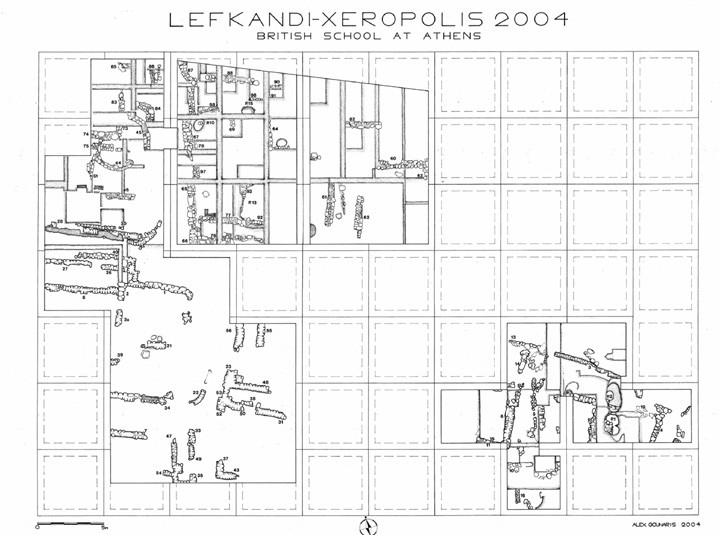 |
The so-called Sub-Mycenaean phase is mostly represented by ceramic material found in various spreads across the site. Interestingly, Area P, located within the 'old excavation', has floor levels and walls – as well as some earths in local depressions of some magnitude – that may yield the first tangible, if fragmented, evidence for structures of this date.
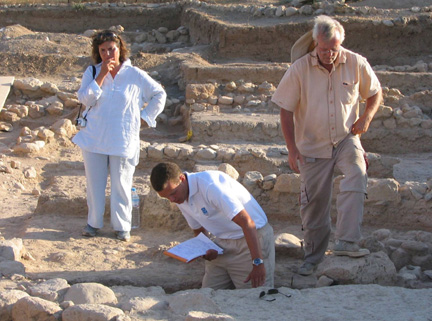 |
 |
Friday
afternoons on site: presentations by trench teams |
Excavation
in progress |
The Early Iron Age is evinced with buildings and spreads dated to the Protogeometric and Sub-Protogeometric stages. In Area P up to four architectural phases span and give continuity between Sub-Mycenaean and PG proper. In Area N, below Popham's Apsidal Building, a substantial deposit of earth is associated with a series of post-holes. Whilst to the east in Area L, at least one wall (Wall 82) bears witness to an edifice of domestic sort in all likelihood.
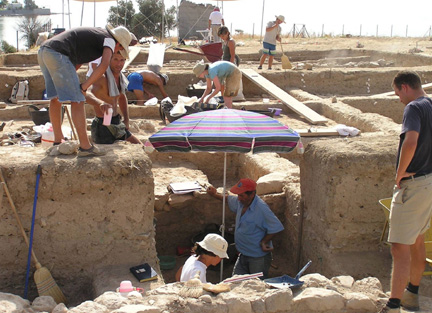 |
Excavation
in progress |
The most impressive piece of evidence of this period, however, is a North/South passage that divides Areas M and H. Originating at the end of the Bronze Age, perhaps as part of a reorganization of this part of the settlement, it is extensively reworked in the Early Iron Age.
This was a flat-based channel, some 1.50 m wide, with a bank at each side, topped by a stone-wall (Walls 65, 66 and 67).
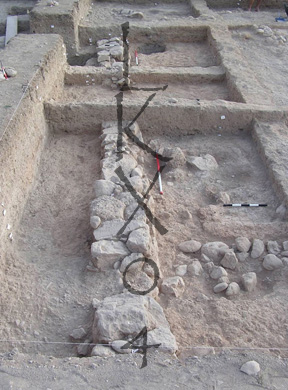 |
| Walls
65, 66 and 67 |
The wall is of more than the usual proportions and built with large slabs and stones. Further work is required here to determine whether the wall turned to run east or west within the settlement.
Whatever its function, this substantial wall marked the west of the N/S passage which perhaps descended the slope to the north to a putative harbour area below and might have been one of the entrances into this part of the settlement. The passage remained in use until sometime at the start of the Late Geometric period. At that time a decision was taken to deliberately infill the way to receive the later structures.
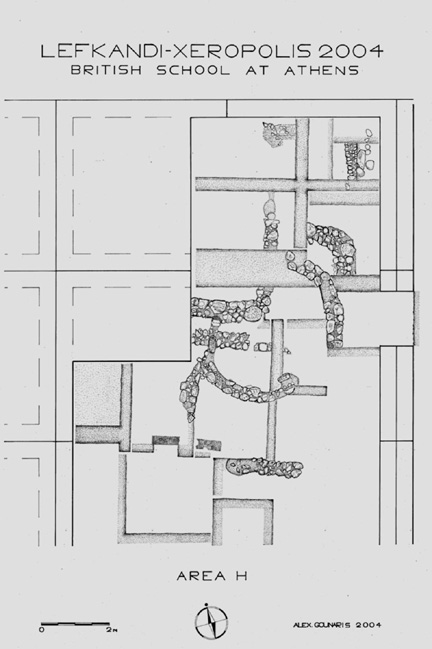 |
Late Geometric structures are also found in the excavatedareas H and M whose character changed after at least the partial and deliberate infilling of the N/S passage. Some of the dumped material comprised a loose mass of stone, bone and sherd with little soil. The ceramics associated with these soils are mostly Sub-Protogeometric and Late Geometric. Further investigation in the area of the Late Geometric, apsidal building (Wall 45) suggests that it was probably accompanied with a possible internal cross-wall (Wall 75), a candidate for a post-base and a potential threshold (Wall 46).
Two other structural areas of Late Geometric date were investigated this year. The first is the Late Geometric structure excavated by Mervyn Popham (now Area N). We resumed research to the north of the limits set by Popham. A few more finds were recovered and some refinements to the earlier plans made (Walls 79, 80 and 81). The second Late Geometric structure lies in the north-west part of Area M: arguably part of another apsidal structure (Wall 87), but now too close to the northern tell edge and on the slope.
Preliminary Finds Report 2004
As in 2003, a large amount of pottery from all the above mentioned periods
was found in this year's excavation too. Among the most interesting pieces
are a number of sherds with pictorial scenes dated to Late Helladic IIIC
middle (Lefkandi, Stage 2); interestingly they are decorated with warrior's
scenes: two of them have scenes with warriors on ships. Extremely important
for the transitional period from the Late Bronze to the Early Iron Age
is the Sub-Mycenaean and Early Protogeometric pottery found in various
areas. Some good quality Sub-Protogeometric and Late Geometric pottery
was also found related with structures and walls of these periods.
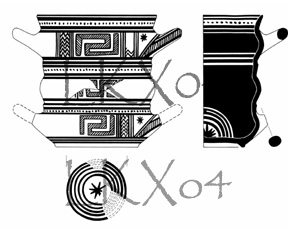 |
An almost complete Middle Geometric II triple skyphos imported from Athens is one of the most celebrated pieces of the 2004 excavation.
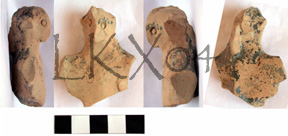 |
Among the small finds a number of figurines were found. The most important is a fragmentary part of a ?Centaur.
Other finds include a LG seal made of steatite and bronze and iron tools, and a copper alloy blade with traces of cloth preserved on it.
Home > New Excavations >2004 Season >2004 Region II>2004 Season Region I>2005 Season